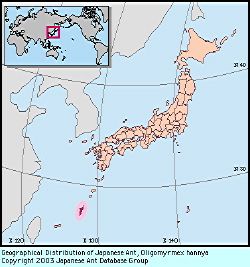
|
species
|
Oligomyrmex hannya
|
 |
Japanese Name
|
Hime-kotsuno-ari
|
Original Reference
|
|
Terayama, M. (1996) Taxonomic studies of the Japanese Formicidae, part 2. Seven genera of Ponerinae, Cerapachyinae and Myrmicinae. Nature and Human Activities, 1, 9-32.
|
Description
|
|
Total length around 1.5 mm in soldiers, around 1 mm or less in workers. The smallest known Japanese myrmicine ant. Body color yellowish brown. In soldiers: head 1.3 times as long as wide, with parallel sides in full face view; vertex with a pair of small tubercles; posterior cephalic margin very weakly concave in the middle; eyes small, with only several facets, situated laterally on the anterior portion of head; mandibles each with 5 teeth; antennae 9-segmented; pronotal and mesonotal dorsa weakly produced; mesonotum simple, not divided into mesoscutum and scutellum; mesopleuron simple; propodeal spines present but small; posterolateral margin of propodeum with a thin lamellate flange extending from the propodeal spine; subpetiolar process spinose; anterior half of head with numerous longitudinal striae, posterior half mostly smooth and impunctate; pronotum smooth and shining; mesonotum, propodeum, petiole and postpetiole covered with small punctures. In workers: head slightly longer than wide in frontal view; antennae 9-segmented; mandibles each with 5 teeth; eyes each with only a single facet, situated laterally on anterior portion of head capsule; propodeum without teeth; posterolateral margins each with a thin lamellate flange which reaches back to the posterodorsal corners of the propodeum; head covered with shallow punctures; pronotum smooth and shining; mesonotum, propodeum, petiole and postpetiole covered with small punctures.
|
Remarks
|
|
This rare species is found in forests and at forest margins, nesting in soil and rotting wood.
|
|

|
References
|
|
- Terayama, M. (1996). Taxonomic studies of the Japanese Formicidae, part 2. Seven genera of Ponerinae, Cerapachyinae and Myrmicinae. Nature and Human Activities, 1, 9-32.
|
Editor
|
|
Original text by Mamoru Terayama and Kazuo Ogata. English translation by Mamoru Terayama, edited by Robert W. Taylor.
|
|